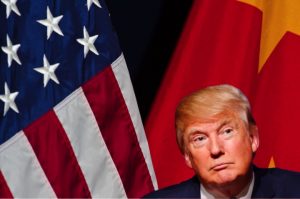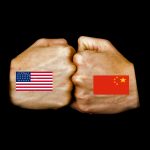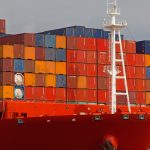Phase One Trade Deal Looking Less Likely
The much toted Phase One Trade Deal between the U.S. and China was hoped to be signed this weekend on the 16th or 17th of November. With the 17th being my birthday, I would have accepted the deal as a nice birthday present. However, it doesn’t look like I’ll be seeing that particular present this weekend.
Of course, those potential signing dates were picked to line up with the Asia-Pacific Economic Cooperation (APEC) summit, not my birthday. But it’s not because the APEC summit was cancelled that we’re not seeing a trade deal signed.
Despite both Washington and Beijing talking like the Phase One Trade Deal was close to being ready for signing just a few weeks ago, giving the world a sense that a new negotiation strategy was resulting in a breakthrough, recent words from President Trump put that sentiment in doubt.
Trump’s Words that Cast Doubt on Phase One Trade Deal

Picture of Donald Trump by Michael Vadon. U.S. & Chinese flags added.
It’s not like the president is talking negatively about the trade deal. He is still very positive in his words about it happening, but there are a couple changes worth noting. Changes that cast doubt about this deal happening this week, this month, or maybe even at all.
President Trump is no longer saying the Phase One Trade Deal is happening but that it could happen.
“We’re close,” the president said about a trade deal with China in a speech this week at the Economic Club of New York. “A significant Phase One Trade Deal with China could happen. It could happen soon.”
There’s an obvious shift in the confidence of the Phase One Trade Deal being reached and signed with the switch from saying we basically have a deal that just needs to be written up and signed to the deal could happen. Even if we’re saying it could happen soon.
Perhaps even more telling are the next words from President Trump in the same speech:
“… we will only accept a deal if it’s good for the United States and our workers and our great companies…”
With those words, President Trump seems to be preparing us for the possible outcome of a deal not being reached at all.
The president is certainly not coming out and saying no deal is coming. In fact, he maintains that things are moving and moving quickly toward a deal. However, reasons for doubt are increasing.
What’s Holding Up the Phase One Trade Deal with China?
According to a Wall Street Journal article by Chao Deng, Lingling Wei, and William Mauldin, the Phase One Trade Deal has hit a snag over farm purchases:
Mr. Trump has said that China has agreed to buy up to $50 billion of soybeans, pork and other agricultural products from the U.S. annually. But China is leery of putting a numerical commitment in the text of an agreement, according to people familiar with the matter.
Yun Li wrote a CNBC article saying in its headline the deal is being held up “because of disagreement on a number of issues.” However, the only issue the article actually adds as one holding up the deal, in addition to the afore-mentioned agricultural purchases issue, is China wanting the U.S. to remove previous tariff hikes:
China is insisting on a rollback of existing tariffs as part of that deal, but the U.S. has showed opposition to such a removal.
This issue may actually be the main holdup of the trade deal. We talked about it in a previous blog post that asks if this is the month we see a U.S.-China trade deal.
It All Comes Back to Tariffs
That China wants the U.S. to cancel upcoming and remove previously implemented tariffs as part of the deal has been widely reported.
From piecing together statements and news accounts, the original Phase One Trade Deal, which the U.S. and China said less than a month ago they’d come together on in principle, included the U.S. at least postponing the upcoming tariffs scheduled for December 15th.
It is extremely unlikely that U.S. negotiators would have agreed for the deal to include any clauses stating the U.S. would not implement any further tariffs. Tariffs are, after all, President Trump’s favorite weapon for creating leverage on China.
It’s impossible to know with certainty all that is happening between the U.S. and China regarding the trade deal without being in the negotiating rooms. However, there is enough information out there to put together a likely timeline of events around the current trade deal strife:
- China and the U.S. come together on a deal in principle, knowing they’ll have to fine tune a written version.
- China asks the deal to include strong guarantees against the U.S. implementing tariffs on Chinese goods along with rollbacks on already implemented tariffs.
- The U.S. refuses the addition.
- China says it will no longer agree to the U.S. ask of $50 billion in spending on U.S. agricultural goods if the U.S. does not include the tariff rollbacks and guarantee.
There certainly could be, and undoubtedly is, more happening behind the scenes than is being reported. However, there’s enough information to reasonably believe this deal got snagged on China’s tariff demand. Additionally, the upcoming December 15th tariff hike is the closest thing this deal has to a deadline.
It all comes back to tariffs.
Will we get a Phase One Trade Deal soon? Well, I’m not staking my birthday happiness on it.




